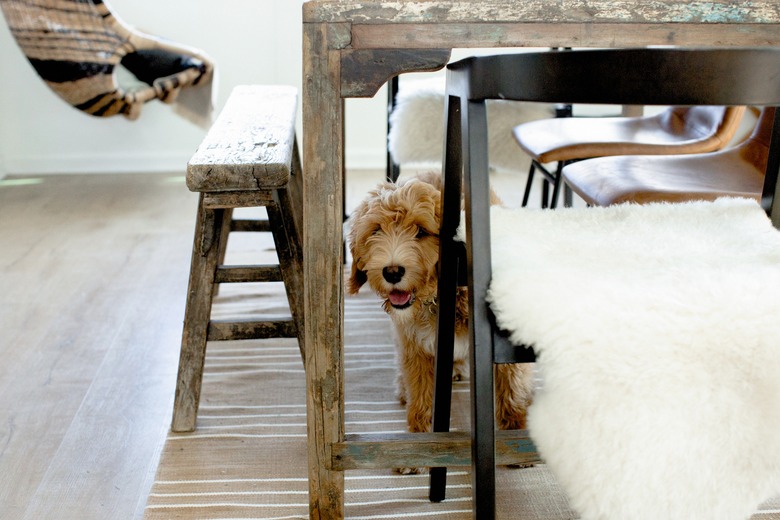How To Remove Carpet Tiles
Thanks to better technology, such as self-adhesive stickers and modern colors and patterns, DIY carpet tiles have seen a surge in popularity. If you are stuck with a room in your house or apartment filled with old carpet squares that are dirty and have seen better days, you may not feel so thankful. Don't despair — this home improvement project is about as simple and straightforward as it can get. You can easily remove modular carpet tiles in no time, and you'll wonder why you waited so long to tackle that outdated carpeting in the first place.
The biggest challenge for this project will be navigating carpeted floor tiles that are stuck to the subfloor. Some carpet tiles may have been installed with their own self-adhesive, while others may have been installed with sticky carpet glue. Removing the carpet squares will be labor intensive, but with the right tools and a little elbow grease, you'll be able to avoid any potential hurdles and setbacks.
What's the best part of this DIY project aside from stepping back and admiring all your hard work in removing carpet that is old and most likely ugly? You'll save yourself a ton of money in subcontractor labor costs.
A Warning About Asbestos
A Warning About Asbestos
While your carpet tiles may look benign, what's lurking underneath and keeping them firmly in place on your floor may not be. If your carpet tile is older than 1980, asbestos-laden adhesives may have been added to the glue that has been keeping your carpet attached to the floor, according to the United States Consumer Product Safety Commission.
If you do suspect that your carpet is 40 years old or more, cut a sample of the carpet with a utility knife along with the adhesive, seal it in a bag and then get it tested by an environmental testing lab. If the test finds asbestos, consult an asbestos abatement company if you want to remove the floor. It's always better to be safe than sorry.
Things Needed
-
Hot water
-
Painters' tape
-
Adhesive remover and/or stripper
-
Knee pads
-
Protective gloves
-
Safety goggles
-
Dust mask
-
Putty knife
-
Utility knife
-
Floor scraper
-
Pliers
-
Wheelbarrow or trash can
-
Rubber boots
-
Rubber gloves
-
Teapot
-
Heat gun (optional)
-
Broom and dustpan
How to Remove Carpet Tiles
1. Pull Up the First Tile
While knee pads, protective gloves, safety goggles and a dust mask may not seem like an obvious necessity when you begin this DIY project, you'll definitely want to protect yourself. Since you'll be bending over and working on your knees, protecting your knees is crucial to avoid causing harm and damage to your joints. Additionally, you'll be pulling up a fiber-filled material, causing dust and small particles to become airborne. This is not something you want to breathe into your lungs or get in your eyes.
- Look for a corner of a carpet tile that may have popped up over time. That carpet square is likely to have less glue and be less resistant to being pulled up. Pull up the carpet tile with your hands. If you can't locate a floor tile with a popped corner, use a putty knife to go between the seams of two tiles and slide the knife under the corner of the tile to pry it up.
- If that still doesn't work, use a utility knife and cut out a notch of the carpet tile, taking care not to gouge the floor beneath it. Then, with the putty knife, pry up the cut piece and use the putty knife to pry up the carpet tile.
- Once a portion of the tile has been lifted from the floor, grab the carpet tile with your hands and remove it.
2. Continue Removing Tiles
Now that the first tile has been removed, removing the rest of the carpet tiles should be relatively easy.
- Slide the end of a floor scraper under the carpet squares, lifting and removing the tiles row by row.
- If they aren't coming up easily with a floor scraper and grabbing the corners of the tile with your hands is proving too taxing, try using pliers to grab, lift and pull the tiles from the floor.
- Stack the carpet squares neatly for easy removal or throw them into a wheelbarrow to transport them to the dumpster.
3. Remove Adhesive Stuck to Tile and Concrete
The type and condition of the subfloor will determine how you'll remove the carpet tile adhesive left behind on the floor. For water-resistant materials like ceramic tile or a concrete floor, hot water — the least toxic and the least abrasive approach — may also be the best tool to remove adhesives.
- Take care not to burn yourself in the process. Be sure to don rubber boots and gloves.
- To try out the hot water method, use a teapot filled with boiling water so you can direct the water onto the most stubborn spots.
- Let the water sit for a minute and then attack the softened glue with a putty knife.
4. Remove Adhesive Stuck to Wood Flooring
As with any job that tackles adhesive stuck to the floor, you can try a heat gun to soften the glue and use a putty knife to try and scrape off the stubborn spots. If you have a wood floor that you'd like to save or if this advice doesn't work on the other types of floors, try this next.
- With the floor scraper or putty knife, manually remove as much of the glue left on the floor as possible.
- Sweep up the debris from the floor with a broom and dustpan and discard into a trash can.
- Protect the baseboards with painters' tape.
- Make sure the room and area is well ventilated. Open the windows and doors for plenty of air circulation.
- Choose an adhesive remover for the type of subfloor you have. Follow the manufacturer's instructions for carpet tile adhesive remover and apply the chemicals.
- With a floor scraper, scrape the remaining glue from the floor.
- Occasionally wipe down the floor scraper to remove any adhesive buildup.
- Tackle tough, resistant spots with the putty knife.
5. Clean Up and Discard Debris
The final step of the process involves cleaning up your work area and safely disposing all debris.
- With the broom and dustpan, sweep up any remaining debris and put it into the trash can or wheelbarrow.
- Discard the carpet, adhesive and dirt in the appropriate trash receptacles. Depending on how much carpet you are discarding, double-check with your waste disposal company or your city to see if it requires a bulk pick-up or if it has designated drop-off centers for items like carpet. Give yourself bonus points if you can locate a recycling facility that will take your old carpet tiles.


